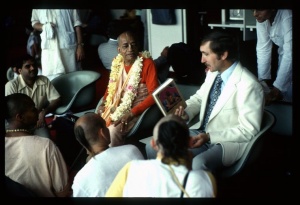CC Adi 10.53 (1975)

A.C. Bhaktivedanta Swami Prabhupada
TEXT 53
- śrī-gadādhara dāsa śākhā sarvopari
- kājī-gaṇera mukhe yeṅha bolāila hari
SYNONYMS
śrī-gadādhara dāsa-of the name Śrī Gadādhara dāsa; śākhā-another branch; sarva-upari-above all; kājī-gaṇera-of the Kāzīs (Muslim magistrates); mukhe-in the mouth; yeṅha-one who; bolāila-caused to speak; hari-the holy name of Hari.
TRANSLATION
Śrī Gadādhara dāsa, the twenty-third branch, was understood to be the topmost, for he induced all the Muslim Kāzīs to chant the holy name of Lord Hari.
PURPORT
About eight or ten miles from Calcutta on the banks of the Ganges is a village known as Eṅḍiyādaha-grāma. Śrīla Gadādhara dāsa was known as an inhabitant of this village (eṅḍiyādaha-vāsī gadādhara dāsa). The Bhakti-ratnākara (Seventh Wave), informs us that after the disappearance of Lord Caitanya Mahāprabhu, Gadādhara dāsa came from Navadvīpa to Katwa. Thereafter he came to Eṅḍiyādaha and resided there. He is stated to be the luster of the body of Śrīmatī Rādhārāṇī, just as Śrīla Gadādhara Paṇḍita Gosvāmī is an incarnation of Śrīmatī Rādhārāṇī Herself. Caitanya Mahāprabhu is sometimes explained to be rādhā-bhāva-dyuti-suvalita, or characterized by the emotions and bodily luster of Śrīmatī Rādhārāṇī. Gadādhara dāsa is this dyuti, or luster. In the Gaura-gaṇoddeśa-dīpikā he is described to be the expansion potency of Śrīmatī Rādhārāṇī. He counts among the associates of both Śrīla Gaurahari and Nityānanda Prabhu; as a devotee of Śrī Caitanya Mahāprabhu he was one of the associates of Lord Kṛṣṇa in conjugal love, and as a devotee of Lord Nityānanda he is considered to have been one of the friends of Kṛṣṇa in pure devotional service. Even though he was an associate of Lord Nityānanda Prabhu, he was not among the cowherd boys but was situated in the transcendental mellow of conjugal love. He established a temple of Śrī Gaurasundara in Katwa.
In 1434 śakābda (A.D. 1513), when Lord Nityānanda Prabhu was empowered by Lord Caitanya to preach the saṅkīrtana movement in Bengal, Śrī Gadādhara dāsa was one of Lord Nityānanda's chief assistants. He preached the saṅkīrtana movement by requesting everyone to chant the Hare Kṛṣṇa mahā-mantra. This simple preaching method of Śrīla Gadādhara dāsa can be followed by anyone and everyone in any position of society. One must simply be a sincere and serious servant of Nityānanda Prabhu and preach this cult door to door.
When Śrīla Gadādhara dāsa Prabhu was preaching the cult of hari-kīrtana, there was a magistrate who was very much against his saṅkīrtana movement. Following in the footsteps of Lord Caitanya Mahāprabhu, Śrīla Gadādhara dāsa one night went to the house of the Kāzī and requested him to chant the Hare Kṛṣṇa mahā-mantra. The Kāzī replied, "All right, I shall chant Hare Kṛṣṇa tomorrow." On hearing this, Śrīla Gadādhara dāsa Prabhu began to dance, and he said, "Why tomorrow? You have already chanted the Hare Kṛṣṇa mantra, so simply continue."
In the Gaura-gaṇoddeśa-dīpikā (verses 154-55) it is said:
- rādhā-vibhūti-rūpā yā
- candrakāntiḥ purā vraje
- sa śrī-gaurāṅga-nikaṭe
- dāsa-vaṁśyo gadādharaḥ
- pūrṇānandā vraje yāsīd
baladeva-priyāgraṇī
- sāpi kārya-vaśād eva
- prāviśat taṁ gadādharam
- Śrīla Gadādhara dāsa is considered to be a united form of Candrakānti, who is the effulgence of Śrīmatī Rādhārāṇī, and Pūrṇānandā, who is the foremost of Lord Balarāma's very dear girlfriends. Thus Śrīla Gadādhara dāsa Prabhu was one of the associates of both Caitanya Mahāprabhu and Nityānanda Prabhu.
Once while Śrīla Gadādhara dāsa Prabhu was returning to Bengal from Jagannātha Purī with Nityānanda Prabhu, he forgot himself and began talking very loudly as if he were a girl of Vrajabhūmi selling yogurt, and Śrīla Nityānanda Prabhu noted this. Another time, while absorbed in the ecstasy of the gopīs, he carried a jug filled with Ganges water on his head as if he were selling milk. When Lord Caitanya Mahāprabhu appeared in the house of Rāghava Paṇḍita while going to Vṛndāvana, Gadādhara dāsa went to see Him, and Śrī Caitanya Mahāprabhu was so glad that He put His foot on his head. When Gadādhara dāsa Prabhu was present in Eṅḍiyādaha he established a Bāla Gopāla mūrti for worship there. Śrī Mādhava Ghoṣa performed a drama known as "Dāna-khaṇḍa" with the help of Śrī Nityānanda Prabhu and Śrī Gadādhara dāsa. This is explained in the Caitanya-bhāgavata, Antya-līlā 5.318-94.
The tomb of Gadādhara dāsa Prabhu, which is in the village of Eṅḍiyādaha, was under the control of the Saṁyogī Vaiṣṇavas and later under the direction of Siddha Bhagavān dāsa Bābājī of Kālnā. By his order, Śrī Madhusūdana Mullik, one of the members of the aristocratic Mullik family of the Nārikelaḍāṅgā in Calcutta, established a pāṭavāṭī (monastery) there in the Bengali year 1256 (A.D. 1849). He also arranged for the worship of a Deity named Śrī Rādhākānta. His son Balāicāṅda Mullik established Gaura-Nitāi Deities there in the Bengali year 1312 (A.D. 1905). Thus on the throne of the temple are both Gaura-Nityānanda Deities and Rādhā-Kṛṣṇa Deities. Below the throne is a tablet with an inscription written in Sanskrit. In that temple there is also a small Deity of Lord Śiva as Gopeśvara. This is all described on a stone by the side of the entrance door.